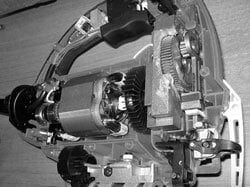the vast majority of jigsaws in the range of controls have electronic components. An electronic regulator is used to select the frequency of the cutting blade stroke, from the minimum to the maximum corresponding to the rated speed of the drive motor.
Electrical components of the jigsaw
The smallest linear speed of the saw blade depends on the values of the efficiency of the motor at  at the minimum rpm. The electronics control the RPM by reducing and increasing the voltage or frequency applied to the motor windings. Smooth increase of control parameters provides “soft start” of the tool, allowing not to move away from the marking when entering the body of the workpiece.
at the minimum rpm. The electronics control the RPM by reducing and increasing the voltage or frequency applied to the motor windings. Smooth increase of control parameters provides “soft start” of the tool, allowing not to move away from the marking when entering the body of the workpiece.
Mechanical components of the jigsaw
Pendulum drive positions
To extend the functionality of the jigsaws, the pendulum drive mechanism incorporates a multistage paging. Usually there are 4 fixed stages that are directly connected to the work support roller. When the control lever is switched, the fork, on the axis of which the support roller of the working web sits, is deflected back, depending on the angle of rotation – the higher the stage, the further.
Thus, the working canvas begins to move not only up and down, but also back and forth. And in the “0” position, the direction of the pendulum stroke is strictly perpendicular to the horizontal plane of the supporting sole. Other steps are used to achieve maximum straight-line sawing speed for materials of different density and thickness.
Angle of inclination of the base plate
To make oblique cuts, it is necessary to set a specified angle on the sole assembly mechanism and lock it in that position. The angle of inclination is not allowed to exceed 45 degrees. Most jigsaw models are equipped with a graduated sector scale, while others have the angle of inclination determined by means of an angle gauge.
Fixation of the tilt position is made by screwing a separate key or a clamping lever, which is much more convenient and accurate.
Changing saw blades
The node of the saw blade fastening to the pendulum rail on modern professional models of jigsaws is modified, it does not require an additional tool for the removal of spent and installation of new blades. The clamping chuck itself performs its functions without external action, and unclamps and releases the saw shank when you press the stop with a finger of your hand. The only thing is that you have to use only specially designed blades.
For the instrumental head tightening models, any saw blade will do.
Airflow systems
Inside the body of the jigsaw, outside air is sucked in as the motor rotor impeller rotates. The incoming flow cools the parts heated by the work and is ejected through the side slots. Some models of the tool can divert the ejected air through a special channel into the zone of contact of the working blade with the material to be sawn with the help of a flap.
This has the effect of blowing out sawdust from the area of the saw, and the amount of air flow can be increased or decreased by moving the flap, depending on the amount of waste produced.
Another option is to use a vacuum cleaner to suck the air out of the sawing area by means of an integrated cavity system. This method does not guarantee 100% removal of all waste products generated during sawing, but it reduces the dustiness of the working space and reduces the chance of injury from flying sawdust.
Use of transparent safety screen
The retractable blade guard on some jigsaw models does double duty. It prevents access to the dangerous sawing area and limits sawdust that spreads while you are sawing. It also provides a visual check of the sawing area.
Sighting devices
To ensure higher accuracy and quickness of the cutting operations the jigsaw is equipped with devices for visual control of the set surface cutting line. The most common is a hinged front sight attached to the front end of the soleplate, while a more advanced system is considered a laser cut direction indicator. The latter system is not always accurate enough, because its components are sometimes displaced by vibration.
Local illumination of the working area provided in some products allows the use of the jigsaw in low visibility conditions and improves visual control of the sawing accuracy.
Auxiliary accessories
The tool set can include auxiliaries to facilitate straight and circular sawing operations. In the first case, set the side sliding stop, which allows you to cut a given width of the workpiece. In the second case, a circular device is used by adjusting the desired radius, bringing or removing the rod with a needle fixed on its end or a roller with a suction cup.
Some jigsaws have an “on” lock button that reduces the burden on the user, and it is usually combined and located on the side of the trigger.
The detachable power cord is convenient when transporting the tool and makes it more mobile. But this feature of the application is quite rare.
Read More: